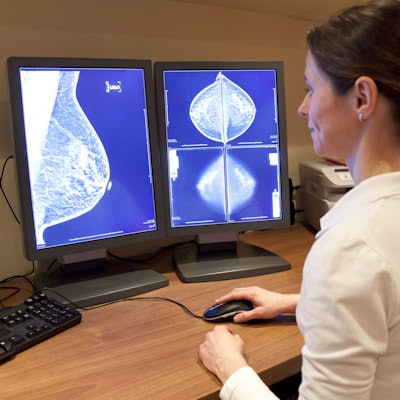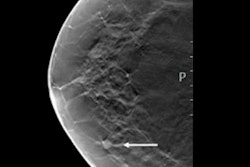
Double reading of digital mammograms may be a waste of time and money, Spanish researchers have found. The evidence of benefit is "scarce," and double reading seems to increase operational costs without translating into a higher cancer detection rate, they noted.
The study team scoured the literature and compared the cancer detection rate, the proportion of false positives, and the cost of double reading versus single reading. Led by Margarita Posso, a doctoral candidate in the methodology of biomedical research and public health program at Universitat Autònoma de Barcelona, the researchers remain unconvinced double reading digital mammograms is the best course of action for screening mammography.
"Too little is currently known about the effectiveness and cost-effectiveness of double reading compared with single reading in the context of digital mammography," they wrote (European Journal of Radiology, 21 September 2017). "The uncertainty on the immediate effects such as cancer detection and false positives of double reading remains large, and there are no publications on long-term health outcomes. Double reading seems to increase operational costs, have a not significantly higher false-positive rate, and [have] a similar cancer detection rate."
To double read or not to double read
European screening guidelines published in 2006 recommend double reading as the strategy of choice for mammogram interpretation, but the recommendations are based on film-screen mammography studies. Does double reading make sense in the context of digital mammography? That's precisely what the researchers sought to discover.
They searched the PubMed, Embase, and Cochrane Library databases up to April 2017, looking for relevant studies. Out of 1,473 possibilities, Posso and colleagues included four -- all of which were published during or after 2014. The total number of screening mammograms was 77,507, with sample sizes from 7,292 to 28,636 for individual studies and included women ages 48 to 69 who underwent biennial mammography screening.
The group found double reading doesn't perform all that much better than single reading (see table).
| Double reading vs. single reading performance | ||
| Double reading | Single reading | |
| Pooled cancer detection rate | 6.01 per 1,000 screens | 5.65 per 1,000 screens |
| Pooled proportion of false positives | 47.03 per 1,000 screens | 40.60 per 1,000 screens |
| Pooled sensitivity | 85.7% | 80.4% |
| Pooled specificity | 95.3% | 95.9% |
In terms of cost-effectiveness, the authors recommend single reading plus computer-aided detection (CAD). One study from Japan found single reading plus CAD extended the number of life years gained by 0.0087 compared with double reading. The incremental cost-effectiveness ratio of single reading plus CAD was $2,951 U.S. (2,496 euros) per life year gained. The incremental cost-effectiveness ratio for double reading was $24,717 U.S. (16,684 euros) per cancer detected.
The researchers noted that the small number and heterogeneity of the studies limit the generalizability of their findings. Also, it's likely the high diagnostic accuracy of single reading comes from the highly trained nature of the radiologists in the studies, and the results may not apply to less trained radiologists.
"We think that further investigation is required to assess the cost-effectiveness of different reading strategies in the context of digital mammography," they wrote. "Single reading is more affordable and easy to implement in all screening programs. On the contrary, the shortage of radiologists may bring difficulties for double reading all mammograms."
In terms of future research, the study team would like to find out more about the utility and cost-effectiveness of single reading plus CAD, and the authors noted that further research is needed on single versus double reading.



















